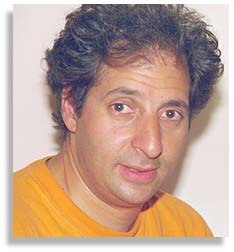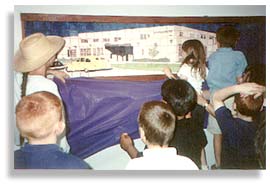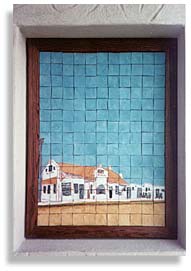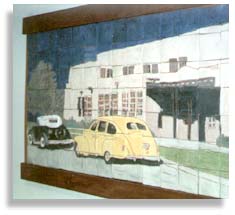|
A Community Sculptor "Taking a piece of clay and transforming it into something beautiful." Interview by Fred Salas San Diego, California
Fred Salas: Andrew you are a sculptor, but as of late you’ve been working with kids quite a bit, young kids, kids-at-risk. You just created some murals with these children - very beautiful murals . Do you want to talk about that process a bit? Why do you like making these tile murals with the kids? Do you like working with kids? Andrew Nagem: Yes. Most kids don't get the chance to really express themselves in a positive, artistic manner -- to experience the feeling of taking a piece of clay and transforming it into something beautiful. That's why I chose to teach them with clay. Clay is so hands on. And it's so easy to learn how to use. Also, once the clay tiles are completed they're more durable, the color lasts, and it has a nice visual texture. There is a nice longevity to it. It doesn't get tired. Fred Salas: Do you always think about the art lasting - as an artist? Is that really important to think about, not just the right-now, but rather how will th epiece be twenty or forty years into the future? Andrew Nagem: It’s like integrity. If you have something falling apart years from now and you still have your name on it, it looks really bad on your statement as to the quality of your work. Also you want it to last so that people can enjoy it for years and not have to deal with it. They won’t have to fix it or repaint it, touch it up. You want them to be able to just spray it with a hose to get the dust off. Fred Salas: I know from knowing you, and looking at pictures of these kids that these children are ninety percent of them young Latino kids, probably under-privileged, at-risk kids - what do you hope to give them? What do you want them to take away from working on this project. Andrew Nagem: One thing is a lasting impression of doing something productive, especially in their school setting which can be very confusing as they are growing up -- Fred Salas: What do you mean by that?
Fred Salas: Just for background, please tell me about Doña Ana County. Andrew Nagem: It’s a southern central section of New Mexico, USA. It’s right near El Paso, and it borders with Mexico. Highway 10 runs through it. It’s very diverse, very beautiful. Unfortunately, there’s a lot of its history which is overlooked or has been destroyed, especially in Las Cruces. Fred Salas: There’s a lot of young poor Latinos there? Andrew Nagem: Yes, and what I like to do is show to them some of the history of the older buildings, where they are from. Some of those buildings are gone now, but most of them are still there though in a different incarnation. The buildings have historical significance and they are an important and needed physical reality in our environment. We are in a fast culture and some kids feel lost. They need something to identify with in their environment. Fred Salas: Something I’ve always wondered about with people who work with kids on a project for a limited amount of time. Do you think that in some cases maybe it does them harm psychologically? Especially young kids. You work so closely with them, they get into the project, they look up to you, they get connected to you, and then all of a sudden it’s over. They might never see you again. Andrew Nagem: On the contrary, what happens is they enjoy participating. I want that to be part of their lives. They can take the experience on the project and re-interpret it throughout their lives. Hopefully they will set good examples later as I do with them. Also I do on occasion see the kids grown up in different settings.
Fred Salas: So, along with hoping that the art will last, you are thinking that their interest or talent will last? Andrew Nagem: I think that if they are really talented they should take that course. But I think that in reality there’s not that many artists. What I’d like them to do is apply what they learn to whatever they take up: nursing or being a doctor, or construction work, anything they decide to do. Even police work. I hope that they take more of an artistic, constructive slant. I think people should appreciate art no matter what they do. Fred Salas: You just said something very interesting. Most of the time you hear that everybody is an artist. But you said that there aren’t that many artists. What do you mean by that? Andrew Nagem: An artist to me is someone who is actually successful in doing art. Fred Salas: Making a living? Andrew Nagem: Yes. Right now I’m about sixty percent making a living in art. About forty other. Fred Salas: What is other? Andrew Nagem: I’m teaching. I do some art works but I’m not making pieces of art that I display in galleries. Fred Salas: Did you miss doing that when you first got out of school? I know you have a bachelor’s and a master’s degree in art. Are you surprised to find yourself working with kids so much, doing so much culture-based art? Andrew Nagem: Yes. I had grander dreams of being a successful artist, of living in any city I wanted to, of being popular. Though I am popular in a different way doing these kind of projects. I like the interaction with the kid groups and adults, and community development. Sometimes I want to do more gallery-type work. I have a lot of pieces that I’ve done that with - but what has stopped me in a way is the marketing aspect. It’s a big machine. Most of these famous artists are really big machines. They are just cranking out fliers and cards and writing letters and trying to get into every show that they can possibly get in to. Every museum. I’m just not interested in putting my energy into that. On the other hand, I’ve won a lot of first prize shows and some of my work has found its way into the homes of serious collectors and organizations. I feel satisfied with what I’ve done. Fred Salas: You should be. I was born and raised in Las Cruces. You have really left a stamp on the city. Your art is all over that city, including the junior high school that I went to. You created the new murals for this junior high school. Do you want to talk about these murals?
The second image is the courthouse and the third one was an early photo fo Court Junior High School taken approximately in 1941. The train depot and the courthouse tile murals were fit into niches in the front door entrance area of Court Junior High School. The niche dimensions left me with a big sky space that gave the train depot image a reaching dimension, a very nice spatial experience. We have such great beautiful blue skies here in Las Cruces. The photo of the school was actually taken in 1941. It’s interesting because those old cars that look like they are from a car show, they were actually new cars at the time. The depot photo was taken in 1910. And the Dan ana courtrhouse photo was taken around 1914. The courthouse at that time stood at the present site of Court Junior High at Court Ave and Armijo streeet in Las Cruces. Anyway, I took these vintage photos from the archives and blew them up inside a computer then tiled them out on eight and half by eleven sheets of paper. From there I transferred the images directly onto wet tile. Fred Salas: The murals are part of a larger project? Andrew Nagem: The mural projects were done as part of a MacArthur Elementary Safe After School program, a pilot after-school activity to keep the kids off the streets. We had a couple of teachers that worked with the kids, some volunteers, and also some mothers were paid to help. The kids did all kinds of activities and one of the activities was doing the art project one day a week for a couple of hours during the afternoon. Fred Salas: How old were the kids? Andrew Nagem: On these projects the ages were from five years old to about nine years old. Fred Salas: Were they mostly Latino kids? Andrew Nagem: Yes. Fred Salas: How about the teachers? Andrew Nagem: They were all Latino. Fred Salas: Will there me more projects like this one? Andrew Nagem: The program is going to continue for the next two years. We just received a new grant and we are going to expand to about six different schools. Fred Salas: It seems it’s a model project all the way around -- using artists such as your self but also artists who are mothers in the community, who have lived in Las Cruces all their lives - like Maria Lopez, a brilliant talented artist. Andrew Nagem: She is actually now a resident artist there. Fred Salas: I also think it is great because I was a second generation child and when I was going to this junior high school it was known as where all the poor Mexicans went. We always had to combat that. Whenever we went to other junior high schools, teachers escorted us because the kids at the other schools would beat us up and throw things at us. But I was very proud of the school. It’s great that it has been re-furbished with these images by yourself and these young Latino kids. It’s poetic justice. |
||||||||||||||||||||||||||||||||||||||||||||||||||||||||||||
| Published in In Motion Magazine December 8, 1999. |
||||||||||||||||||||||||||||||||||||||||||||||||||||||||||||
If you have any thoughts on this or would like to contribute to an ongoing discussion in the  What is New? || Affirmative Action || Art Changes || Autonomy: Chiapas - California || Community Images || Education Rights || E-mail, Opinions and Discussion || En español || Essays from Ireland || Global Eyes || Healthcare || Human Rights/Civil Rights || Piri Thomas || Photo of the Week || QA: Interviews || Region || Rural America || Search || Donate || To be notified of new articles || Survey || In Motion Magazine's Store || In Motion Magazine Staff || In Unity Book of Photos || Links Around The World NPC Productions Copyright © 1995-2020 NPC Productions as a compilation. All Rights Reserved. |
||||||||||||||||||||||||||||||||||||||||||||||||||||||||||||





